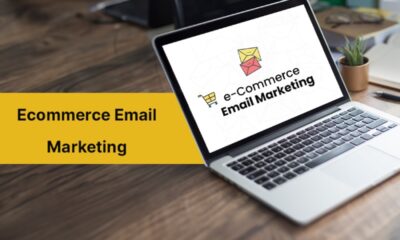Startup
4-Step Plan Marketers Can Use to Drive Business Growth With Email Marketing

Many firms still rely on one-time designs or intermittent mailings for marketing. But the best teams use a different approach. They carefully design every email marketing campaign. Attracting readers is the goal of every single email. This strategy helps achieve more important business goals and boosts conversions.
Your offer or audience may not be the issue if your open rates fluctuate a lot, your click-through rate is low, or you feel that the quantity of clicks is poor. It probably has to do with your procedure.
Businesses employ this four-step process to expand in specific industries. They use it to create email marketing campaigns. These programs aim to inspire the right people to take action.
1. Developing attention-grabbing subject lines
Your brand is not the only thing that subject lines convey. They significantly enhance the effectiveness of your emails. According to research, the relevancy of the subject line affects how frequently an individual opens an email. That initial impression is crucial for nearly half of all email opens.
Mobile devices respond well to effective subject lines. They frequently evoke powerful emotions or sentiments.
Using email marketing tools like Campaign Monitor, Mailchimp, or CRM platforms, top email marketers constantly test their subject lines. To increase open rates, they take this action. Ensuring that their messaging aligns with their landing pages and complements their content marketing approach is also beneficial.
2. How to maintain focus in ten words
Your subject line is crucial if you want people to read your material. The first line grabs the reader’s attention. The importance of the preview text is often overlooked by marketing managers. This text appears next to the topic line in the inbox. It serves as an extra hook, especially for users of mobile devices.
Instead of utilizing conventional openings, try these efficient methods to generate powerful first lines:
- Many email campaigns fail not because of bad content but rather because they are poorly structured.
- The issue may arise if your email list is growing, yet your sales are not increasing.
- Instead of sending too few emails, you’re sending the incorrect ones.
AI tools, automation, and audience segmentation are now available to email marketers. This enables them to create customized messages according to various criteria. These elements may include prior levels of participation, timeliness, currency exchange rates, or behavior. This ensures that every email is sent at the appropriate time and contains pertinent information.
3. Writing with a framework first
Email content shouldn’t read like a typical blog or feel like notes. It should offer quick, easy-to-read information that is clear and beneficial. The messaging must lead consumers through your sales process and align with your overarching strategy.
Every effective email marketing campaign consists of:
- You can better comprehend your audience if you have a good understanding of their problem.
- A gift card, a demo, a free trial, or a special offer can all be effective solutions.
- Readers should be directed to landing sites or app sign-ups with a call to action.
Every communication is connected by marketers to their email marketing plan. This maintains organization through automated procedures, newsletters, and a sequence of emails.
Email marketing platforms such as Mailchimp and the High Levels integrated platform can provide marketers with information. They can monitor how many times their emails have been clicked. They can produce better templates as a result. Additionally, it lessens the likelihood that their emails would be flagged as spam. They increase audience trust and brand exposure by doing this.
4. CTAs with an effect
The success or failure of each campaign is determined by its call to action.
Calls to action, or CTAs, that convert well direct readers to the next step. They simplify things and provide step-by-step instructions. This could entail scheduling a demo through your app, utilizing a gift card, or initiating a free trial.
Sending emails to inboxes is only one aspect of a successful email marketing plan. It’s about assisting people in achieving their objectives as well. This entails employing automation, personalizing your emails, and crafting compelling, concise copy. Everything in the message, including the final sentence, counts.
You can monitor the effectiveness of your CTAs by linking your CRM to your campaign statistics. You may examine crucial metrics like clicks, open rates, and the amount of time visitors remain interested. As time passes, you can use this information to refine your approach.
Why Organized Email Performs Better Than Unplanned Campaigns
Email remains a vital channel in a crowded market. This is because it is extremely accurate, not because it is new.
The companies with the highest return on investment are not merely fortunate or reliant on successful email marketing strategies. They focus on well-organized processes and tried-and-true techniques. These strategies emphasize timing, value delivery, and clear communication.
Email should be viewed as more than just a means of information sharing, whether you’re working with a complex sequence of emails, producing seasonal newsletters, or starting your first automated flow. Consider it a helpful tool for your plan.
Email is more than just a message delivery tool when your brand awareness objectives align with significant commercial outcomes. It turns becomes a strong tool.
-

 Lifestyle4 weeks ago
Lifestyle4 weeks agoBob Gerace Discusses Coaching Themes: Confession, Reconciliation, Communication, Intimacy, and Fatherhood
-

 Education3 weeks ago
Education3 weeks agoAn Exclusive Interview With Holly Gold: The Heart and Vision Behind The Little Schools
-

 Travel4 weeks ago
Travel4 weeks ago8000 Voices, One Vibe — Ludhiana Sang Every Word with Talwiinder at Bangr Arena
-

 Business3 weeks ago
Business3 weeks agoCorporate Event Catering in Manchester: What Businesses Need to Know (and why Manchester sets the bar)
-
Tech4 weeks ago
Harrington Quality Management System (HQMS): Flagship Platform of Harrington Group International
-

 Business3 weeks ago
Business3 weeks agoCorporate Christmas Gifting Makes a Big Comeback
-

 Apps3 weeks ago
Apps3 weeks agoCanva Launches AI-Powered Design Model and New Creative Features
-

 Travel3 weeks ago
Travel3 weeks agoExploring Europe’s Most Photogenic Cities for Your Next Trip


















